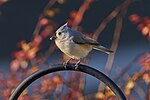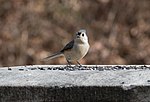The tufted titmouse (Baeolophus bicolor) is a small songbird from North America, a species in the tit and chickadee family (Paridae). The black-crested titmouse, found from central and southern Texas southward,[2] was included as a subspecies but now is considered a separate species, Baeolophus atricristatus.[3]
Taxonomy
The genus name Baeolophus translates to small crested and is a compound of the Ancient Greek words βαιός: baiós—"small", and λόφος: "lόphοs"—crest. The species name bicolor means two-colored.
Description
Measurements:[4]
- Length: 5.5–6.3 in (14–16 cm)
- Weight: 0.6–0.9 oz (17–26 g)
- Wingspan: 7.9–10.2 in (20–26 cm)
These small birds have a white front and grey upper body outlined with rust colored flanks. Other characteristics include their black foreheads and the tufted grey crest on their heads.[5] In juveniles, the black forehead is greatly diminished such that they may be confused with the oak titmouse (although their ranges do not overlap). Males tend to be larger than females.[6]
The song of the tufted titmouse is usually described as a whistled peter-peter-peter, although this song can vary in approximately 20 notable ways.[7]
Distribution and habitat
Its habitat is deciduous and mixed woods as well as gardens, parks, and shrublands. Although the tufted titmouse is non-migratory and originally native to the Ohio and Mississippi River basins, factors such as bird feeders have caused these birds to occupy a larger territory across the United States and stretching into Ontario and Quebec in Canada.[5][6][8] During the second half of the 20th century and into the 21st century, the species' range has been expanding northwards.[4]
Behavior and ecology
The tufted titmouse gathers food from the ground and from tree branches, frequently consuming a variety of berries, nuts, seeds, small fruits, insects, and other invertebrates.[9] Caterpillars constitute a major part of its diet during the summer. This species is also a regular visitor to bird feeders.[10] Its normal pattern is to scout a feeder from cover, fly in to take a seed, then fly back to shelter to consume the morsel, though caching is also very common.[9][11]
The titmouse can demonstrate curiosity regarding humans and sometimes will perch on a window ledge and seem to be peering into the house. It may also cling to the window frames and walls of buildings seeking prey in wasp and hornet nests.[citation needed]
Titmice are very vocal and will respond to sounds of agitation in other birds.[4] This species readily forms small flocks, known as troupes or banditries, which often associate with chickadees and other passerines when foraging.[12]
Breeding
Tufted titmice nest in a hole in a tree, either a natural cavity, a human-made nest box, or sometimes an old woodpecker nest.[13] They line the nest with soft materials, sometimes plucking hair from live mammals to use as material, a behavior known as kleptotrichy.[14][15] If they find snake skin sheds, they may incorporate pieces into their nest.[16] Eggs measure under 1 inch (2.5 centimetres) long and are white or cream-colored with brownish or purplish spots.[17] Eggs have an incubation period of 12–14 days; titmice will then remain nestlings for 15–16 days.[4]
The lifespan of the tufted titmouse is approximately 2.1 years, although it can live for more than ten years.[18] On average, these birds will have a clutch size of five to seven eggs.[19] Unlike many birds, the offspring of tufted titmice will often stay with their parents during the winter and even after the first year of their life.[20] Sometimes, a bird born the year before will help its parents raise the next year's young.[21]
Tufted titmice will occasionally hybridize with the black-crested titmouse; the hybridization range is very narrow, however, because of genetic differences.[6]
Status
From 1966 to 2015 the tufted titmouse population has increased by more than 1.5% per year throughout the northeastern U.S.[22] The current breeding population is estimated to be approximately 8 million.[4]
Gallery
References
- ^ BirdLife International (2016). "Baeolophus bicolor". IUCN Red List of Threatened Species. 2016: e.T22711983A94314102. doi:10.2305/IUCN.UK.2016-3.RLTS.T22711983A94314102.en. Retrieved 11 November 2021.
- ^ Kaufman, Kenn (13 November 2014). "Black-crested Titmouse". National Audubon Society. Retrieved 13 October 2019.
- ^ Banks, Richard C.; Cicero, Carla; Dunn, Jon L.; Kratter, Andrew W.; Rasmussen, Pamela C.; Remsen, J. V.; Rising, James D.; Stotz, Douglas F. (1 July 2002). "Forty-Third Supplement to The American Ornithologists' Union Check-List of North American Birds". The Auk. 119 (3): 897–906. doi:10.1093/auk/119.3.897. Retrieved 13 October 2019.
- ^ a b c d e "Tufted Titmouse Identification, All About Birds, Cornell Lab of Ornithology". www.allaboutbirds.org. Retrieved 28 September 2020.
- ^ a b McCommons, James (2003). "Tufted Titmouse". Emmaus. 50: 16. ProQuest 203733124.
- ^ a b c "Tufted Titmouse (Baeolophus bicolor) General Biology |". Retrieved 18 February 2022.
- ^ Grubb, Thomas C. (1998). Tufted Titmouse. Stackpole Books. ISBN 9780811729673.
- ^ "Tufted Titmouse" (PDF). Ohio Birds. Retrieved 4 May 2018.
- ^ a b "Tufted Titmouse". Audubon. 13 November 2014. Retrieved 5 March 2022.
- ^ Montgomery, Sy. "Titmouse". Encyclopædia Britannica. Retrieved 13 October 2019.
- ^ "Tufted Titmouse - Diet". National Audubon Society. 13 November 2014. Retrieved 13 October 2019.
- ^ Parnell, Marc (2022). Birds of Connecticut (The Birding Pro's Field Guides). Cleveland, Ohio: Naturalist & Traveler Press. pp. 214–215. ISBN 978-1-954228-27-6.
- ^ Laskey, Amelia. "Some Tufted Titmouse Life History" (PDF). Retrieved 4 May 2018.
- ^ "Tufted Titmouse, Audubon Field Guide". 13 November 2014. Retrieved 17 August 2015.
- ^ Pollock, Henry S.; MacDonald, Sean E.; Vizentin-Bugoni, Jeferson; Brawn, Jeffrey D.; Sutton, Zachary S.; Hauber, Mark E. (2021). "What the pluck? Theft of mammal hair by birds is an overlooked but common behavior with fitness implications". Ecology. 102 (12): e03501. Bibcode:2021Ecol..102E3501P. doi:10.1002/ecy.3501. PMID 34314035. S2CID 236453003 – via Wiley Online Library.
- ^ Medlin, Elizabeth C.; Risch, Thomas S. (2006). "An Experimental Test Of Snake Skin Use To Deter Nest Predation". The Condor. 108 (4): 963. doi:10.1650/0010-5422(2006)108[963:aetoss]2.0.co;2. ISSN 0010-5422. S2CID 86039366.
- "The use of sloughed black rat snake Elaphe obsolete skins deters predation of artificial nests in nest boxes in forest near Jonesboro, Craighead County, Arkansas, USA". Conservation Evidence. Archived from the original on 3 January 2009.
- ^ "Common Nesting birds - Tufted Titmouse (Baeolophus bicolor)". Nest Watch. Retrieved 13 October 2019.
- ^ Elder, William H. (1985). "Survivorship in the Tufted Titmouse" (PDF). Wilson Bull. 97: 517–524 – via ProQuest.
- ^ Laskey, Amelia R. (July 1957). "Some Tufted Titmouse Life History" (PDF). Bird-Banding. 28 (3): 135–145. doi:10.2307/4510633. JSTOR 4510633 – via ProQuest.
- ^ Pravosudova, Elena V.; Grubb, Thomas C.; Parker, Patricia G.; Doherty, Paul F. (1999). "Patch Size and Composition of Social Groups in Wintering Tufted Titmice". The Auk. 116 (4): 1152–1155. doi:10.2307/4089699. JSTOR 4089699.
- ^ "All About Birds - Tufted Titmouse". Cornell Lab of Ornithology. Retrieved 13 October 2019.
- ^ "Tufted & Black-crest. Titmou Baeolophus bicolor/atricrista". Patuxent Wildlife Research Center. U.S. Geological Survey. Retrieved 2 January 2019.
External links
- "Tufted titmouse media". Internet Bird Collection.
- Tufted titmouse species account – Cornell Lab of Ornithology
- Tufted titmouse – Baeolophus bicolor – USGS Patuxent Bird Identification InfoCenter
- Tufted titmouse photo gallery at VIREO (Drexel University)
|
Help
|
|
Browse
|
Search
|
Create the page "Tufted Titmouse" on this wiki!
- 4.0 Creative Commons Attribution-Share Alike 4.0 truetrue English Tufted titmouse (Baeolophus bicolor) in Prospect Park, Brooklyn, NY USA object has...(2,884 × 2,279 (3.28 MB)) - 16:16, 5 March 2024
- 4.0 Creative Commons Attribution-Share Alike 4.0 truetrue English Tufted titmouse fluffed up with beak open in the Central Park Ramble (New York City...(2,572 × 2,870 (4.71 MB)) - 16:15, 5 March 2024
- 4.0 Creative Commons Attribution-Share Alike 4.0 truetrue English Tufted titmouse at a feeder Wikimedia username: Rhododendrites author name string:...(3,289 × 2,679 (3.37 MB)) - 21:08, 5 March 2024
- 4.0 Creative Commons Attribution-Share Alike 4.0 truetrue English Tufted titmouse in Green-Wood Cemetery Wikimedia username: Rhododendrites author name...(2,219 × 2,557 (1.99 MB)) - 17:38, 5 March 2024
- 4.0 Creative Commons Attribution-Share Alike 4.0 truetrue English Tufted titmouse (''Baeolophus bicolor'') in Central Park. URL: https://commons.wikimedia...(2,967 × 2,376 (3.59 MB)) - 17:37, 28 May 2023
- 4.0 Creative Commons Attribution-Share Alike 4.0 truetrue English Tufted titmouse in Green-Wood Cemetery Wikimedia username: Rhododendrites author name...(2,275 × 2,517 (2.41 MB)) - 17:38, 5 March 2024
- 4.0 Creative Commons Attribution-Share Alike 4.0 truetrue English Tufted titmouse sticking head out of a hole in a dead tree URL: https://commons.wikimedia...(2,932 × 2,785 (5.22 MB)) - 01:04, 5 March 2024
- 4.0 Creative Commons Attribution-Share Alike 4.0 truetrue English Tufted titmouse in Green-Wood Cemetery, Brooklyn author name string: Rhododendrites...(3,570 × 2,725 (6.31 MB)) - 03:22, 5 March 2024
- 4.0 Creative Commons Attribution-Share Alike 4.0 truetrue English Tufted titmouse sticking head out of a hole in a dead tree URL: https://commons.wikimedia...(4,608 × 3,456 (10.74 MB)) - 01:03, 5 March 2024
- 4.0 Creative Commons Attribution-Share Alike 4.0 truetrue English Tufted titmouse in Central Park author name string: Rhododendrites Wikimedia username:...(4,608 × 3,456 (9.25 MB)) - 03:23, 5 March 2024
- 4.0 Creative Commons Attribution-Share Alike 4.0 truetrue English Tufted Titmouse, Glastonbury, CT USA author name string: Paul Danese Wikimedia username:...(4,833 × 3,222 (9.76 MB)) - 22:36, 5 May 2024
- 4.0 Creative Commons Attribution-Share Alike 4.0 truetrue English Tufted titmouse opened a seed in Prospect Park (Brooklyn, NY, USA) object has role:...(3,642 × 2,882 (6.51 MB)) - 16:16, 5 March 2024
- 4.0 Creative Commons Attribution-Share Alike 4.0 truetrue English Tufted titmouse in Prospect Park object has role: photographer author name string:...(3,463 × 2,721 (5.05 MB)) - 16:16, 5 March 2024
- user names refer to en.wikipedia. 2006-03-12 22:14 Mwanner 368×494×8 (51969 bytes) Tufted Titmouse. Taken by [[User:Mwanner]], 26 Feb, 2006. English...(368 × 494 (51 KB)) - 17:26, 16 April 2022
- this work, hereby publish it under the following license: English A tufted titmouse "stands" on a branch. Lojban .ni'o le cipni be la'o banlu'atu. baeolophus...(3,003 × 2,002 (3.76 MB)) - 11:55, 21 June 2022
- it under the following license: English Slow motion. Hand-feeding a Tufted Titmouse at Firestone Metro Park in Akron, OH author name string: Equationsmith...(WebM VP8 video file, 37 s) - 22:48, 20 April 2024
- endorses you or your use. https://creativecommons.org/licenses/by/4.0CC BY 4.0 Creative Commons Attribution 4.0 truetrue English tufted titmouse in tree...(3,047 × 2,285 (7.38 MB)) - 04:27, 7 January 2024
- org/licenses/by/4.0CC BY 4.0 Creative Commons Attribution 4.0 truetrue English Tufted titmouse on tree author name string: Candeadly Wikimedia username: Candeadly...(4,000 × 3,000 (3.12 MB)) - 16:21, 3 February 2024
- org/licenses/by/4.0CC BY 4.0 Creative Commons Attribution 4.0 truetrue English Tufted Titmouse and bird feeder author name string: Candeadly Wikimedia username: Candeadly...(4,000 × 3,000 (4.37 MB)) - 16:21, 3 February 2024
- 4.0 Creative Commons Attribution-Share Alike 4.0 truetrue English Tufted titmouse in Prospect Park URL: https://commons.wikimedia.org/wiki/user:Rhododendrites...(1,936 × 1,315 (1.26 MB)) - 02:42, 4 September 2023
























Recent Comments